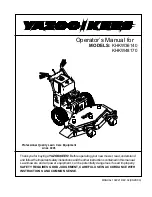
27
Viscosity: See table below
F
–20
0
20
40
60
80
100
5
C
–30
5
–20
–10
0
10
20
30
40
USE THESE SAE VISCOSITY OILS
32
10W–30
5W–20, 5W–30
Checking the Engine Oil Level
1. Disengage the power take off (PTO), set the parking
brake and turn the engine off.
1. Park the machine on a level surface, disengage the
power take off (PTO), set the parking brake, and turn
the engine off.
2. Clean around the oil dipstick (Fig. 33) so dirt cannot
fall into the filler hole and damage the engine.
3. Unscrew the oil dipstick and wipe the metal end clean
(Fig. 33).
4. Slide the oil dipstick fully into the filler tube, do not
thread onto tube (Fig. 33). Pull the dipstick out and look
at the metal end. If oil level is low, slowly pour only
enough oil into the filler tube to raise the level to the
full mark.
Important
Do not overfill the crankcase with oil
because the engine may be damaged.
1
2
3
Figure 33
1.
Oil dipstick
2.
Metal end
3.
Filler tube
Changing the Engine Oil
1. Start the engine and let it run five minutes. This warms
the oil so it drains better.
2. Park the machine so that the drain side is slightly lower
than the opposite side to assure the oil drains
completely. Then disengage the power take off (PTO),
set the parking brake, and turn the engine off.
3. Place a pan below the oil drain. Remove the oil drain
cap (Fig. 34).
4. When oil has drained completely, install the oil drain
cap.
Note: Dispose of the used oil at a certified recycling center.
1
m–4758
Figure 34
1.
Oil drain cap
5. Slowly pour approximately 80% of the specified oil on
page 26, into the filler tube (Fig. 33). Now check the oil
level; refer to Checking Oil Level, page 27. Slowly add
additional oil to bring to full mark on dipstick.














































